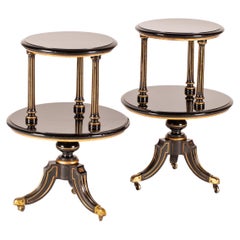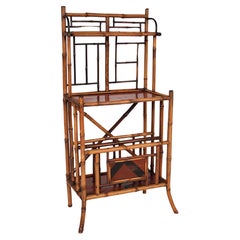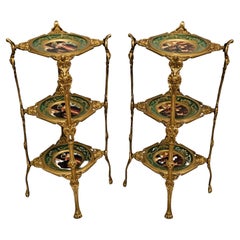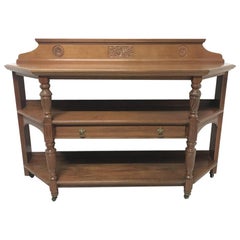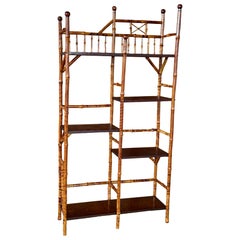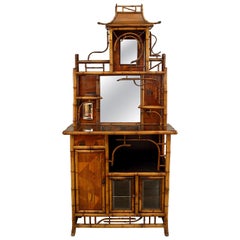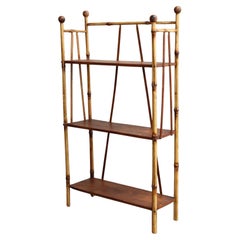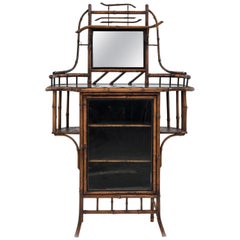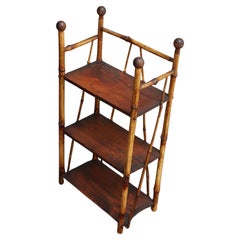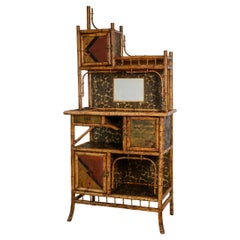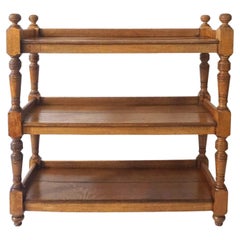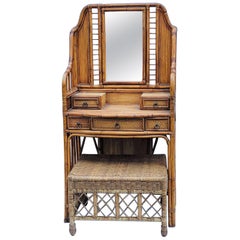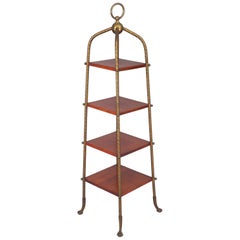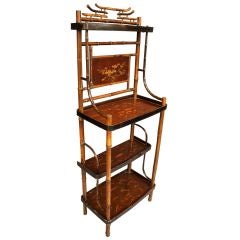Aesthetic Movement Etagere
Antique 19th Century English Aesthetic Movement Side Tables
Wood
Vintage 1910s European Aesthetic Movement Shelves
Bamboo, Lacquer
Antique Late 19th Century French Aesthetic Movement Side Tables
Bronze
Antique 1880s English Aesthetic Movement Buffets
Oak
Antique Late 19th Century Unknown Victorian Shelves
Bamboo
Antique 19th Century Aesthetic Movement Bookcases
Bamboo, Mirror
Early 20th Century American Aesthetic Movement Shelves
Bamboo, Walnut
Antique Late 19th Century Unknown Aesthetic Movement Bookcases
Bamboo, Lacquer
Early 20th Century American Aesthetic Movement Shelves
Metal
Antique Late 19th Century French Aesthetic Movement Cabinets
Bamboo, Lacquer, Paper
Antique 1870s English Aesthetic Movement Shelves
Oak
1990s Philippine Aesthetic Movement Vanities
Bamboo, Wicker, Wood
Recent Sales
Antique 1880s American Aesthetic Movement Bookcases
Brass
Antique 19th Century English Shelves
20th Century Aesthetic Movement Cabinets
Faux Bamboo, Lacquer
Antique Late 19th Century American Aesthetic Movement Cabinets
Mahogany
Vintage 1910s Unknown Aesthetic Movement End Tables
Bamboo, Wood, Lacquer, Paint
Early 20th Century English Aesthetic Movement Bookcases
Bamboo, Wood
Antique Late 19th Century English Aesthetic Movement Cabinets
Bamboo, Mirror, Wood
Antique Late 19th Century English Aesthetic Movement Shelves
Bamboo, Wood, Lacquer
Antique Late 19th Century English Aesthetic Movement Shelves
Bamboo, Wood, Lacquer, Paint
Antique Late 19th Century English Aesthetic Movement Shelves
Bamboo, Wood, Lacquer
Early 20th Century English Aesthetic Movement Shelves
Bamboo, Wood
Antique Late 19th Century English Aesthetic Movement Shelves
Brass
Antique Late 19th Century English Aesthetic Movement Cabinets
Bone, Bamboo, Mirror, Lacquer
Antique Late 19th Century English Aesthetic Movement Cabinets
Brass
Antique 19th Century English Shelves
Cherry
Antique 1870s English Aesthetic Movement Bookcases
Brass
Antique Late 19th Century English Aesthetic Movement Shelves
Bamboo, Wood, Lacquer
Antique 1890s American Aesthetic Movement Vitrines
Bronze
Antique Late 19th Century Unknown Aesthetic Movement Shelves
Bamboo
Early 20th Century Aesthetic Movement Shelves
Walnut
Vintage 1920s Austrian Aesthetic Movement Vitrines
Brass, Copper
Antique Late 19th Century British Aesthetic Movement Bookcases
Bamboo, Lacquer
Antique 19th Century English Aesthetic Movement Shelves
Glass, Wood, Lacquer, Bamboo
Antique 1880s American Aesthetic Movement Cabinets
Glass, Wood
Antique 19th Century British Aesthetic Movement End Tables
Antique Late 19th Century English Aesthetic Movement Shelves
Bamboo, Mirror, Lacquer
Late 20th Century American Aesthetic Movement Shelves
Metal
Antique Late 19th Century French Japonisme Tables
Bronze
Antique Late 19th Century English Aesthetic Movement Shelves
Brass
Late 20th Century American Aesthetic Movement Shelves
Bamboo, Wood
Antique Late 19th Century American Aesthetic Movement Side Tables
Walnut
Early 20th Century English Aesthetic Movement Shelves
Bamboo, Oak
Antique Late 19th Century English Aesthetic Movement Side Tables
Bamboo, Wood, Lacquer, Paint
Antique 1880s American Aesthetic Movement Shelves
Wicker, Rattan
Mid-20th Century Unknown Aesthetic Movement Shelves
Bamboo
Early 20th Century British Aesthetic Movement Shelves
Brass
Early 20th Century Chinese Aesthetic Movement Cabinets
Bamboo
Early 20th Century American Aesthetic Movement Shelves
Bamboo, Wood
Antique Mid-19th Century English Dressers
Bamboo
Antique 1870s English Aesthetic Movement Shelves
Beech
Antique 19th Century English Aesthetic Movement Corner Cupboards
Bamboo, Lacquer
Antique 19th Century English Cabinets
Bamboo, Alkyd
People Also Browsed
Vintage 1970s American Modern Lounge Chairs
Stainless Steel
21st Century and Contemporary Vietnamese Empire Center Tables
Wood
2010s American Organic Modern Vases
Ceramic
Antique 19th Century Bergere Chairs
Fabric, Wood, Paint
Antique 1840s French Wardrobes and Armoires
Oak
Antique 1890s British Late Victorian Vitrines
Mahogany
19th Century Rococo Figurative Paintings
Oil
Antique Early 1900s Italian Baroque Revival Figurative Sculptures
Carrara Marble
Antique Late 19th Century European Louis Philippe Commodes and Chests of...
Marble
Antique Late 19th Century French French Provincial Armchairs
Linen, Upholstery, Oak
20th Century American Organic Modern Armchairs
Fabric, Bamboo, Rattan, Wood
Antique Mid-19th Century French Régence Vases
Bronze
Antique Late 19th Century Italian Louis XV Chaise Longues
Gold Leaf
Early 20th Century French Dinner Plates
Ironstone
Antique 1860s Swedish Victorian Sideboards
Wood
Antique Early 18th Century French Baroque Western European Rugs
Wool, Silk
Aesthetic Movement Etagere For Sale on 1stDibs
How Much is a Aesthetic Movement Etagere?
A Close Look at Aesthetic-movement Furniture
In 1880, polymath designer William Morris declared: “If you want a golden rule that will fit everybody, this is it: Have nothing in your houses that you do not know to be useful or believe to be beautiful.” His words encapsulated the Aesthetic Movement, which prized beauty above all and blurred the lines between fine art and the decorative arts, particularly through lavishly crafted furniture pieces.
The Aesthetic Movement, whose major proponents included author Oscar Wilde, flourished from the 1860s to the 1880s and was mostly popular in England and the United States. Design expositions like the 1876 Centennial International Exhibition in Philadelphia, as well as the publishing of how-to books for interior design, helped disseminate Aesthetic Movement bedroom furniture, serveware, coffee tables and other items, especially to the middle class.
The establishment of new art museums, art clubs and a rising passion for collecting at the time contributed to a growing appreciation for art. Morris’s founding of Morris & Co. in 1862 and the commercializing of this “cult of beauty” by the Liberty store in London, starting in the late 19th century, further disseminated the idea of a domestic space that was thoughtfully and floridly designed.
Leading Aesthetic Movement furniture designers included E.W. Godwin, who drew on Japanese influences and whose work reflected a wider enthusiasm for imported East Asian art. British designer Christopher Dresser created textiles, ceramics and more that were also inspired by Japanese decorative art but were representative of additional diverse design sources that ranged from Egypt to Mexico.
The Aesthetic Movement’s eclecticism resulted in dazzling interiors. Japanese fans were positioned on Renaissance-inspired cabinets with brass hardware, while mantels made of rich walnut or finely carved ebonized wood and adorned with painted Minton tiles mingled with cast-iron chairs against a backdrop of floral wallpaper. In 1881, in New York City, stenciled checkerboard motifs and painted floral murals could be found under an opalescent glass chandelier in a luxurious dressing room designed by German émigré cabinetmaker-decorator George Alfred Schastey. Amid the rise of the industrial age, the style’s promotion of art in everyday life would inform the Arts and Crafts Movement and Art Nouveau.
Find a collection of antique Aesthetic Movement seating, tables, decorative objects and other furniture and antiques on 1stDibs.
Finding the Right Case Pieces And Storage Cabinets for You
Of all the vintage storage cabinets and antique case pieces that have become popular in modern interiors over the years, dressers, credenzas and cabinets have long been home staples, perfect for routine storage or protection of personal items.
In the mid-19th century, cabinetmakers would mimic styles originating in the Louis XIV, Louis XV and Louis XVI eras for their dressers, bookshelves and other structures, and, later, simpler, streamlined wood designs allowed these “case pieces” or “case goods” — any furnishing that is unupholstered and has some semblance of a storage component — to blend into the background of any interior.
Mid-century modern furniture enthusiasts will cite the tall modular wall units crafted in teak and other sought-after woods of the era by the likes of George Nelson, Poul Cadovius and Finn Juhl. For these highly customizable furnishings, designers of the day delivered an alternative to big, heavy bookcases by considering the use of space — and, in particular, walls — in new and innovative ways. Mid-century modern credenzas, which, long and low, evolved from tables that were built as early as the 14th century in Italy, typically have no legs or very short legs and have grown in popularity as an alluring storage option over time.
Although the name immediately invokes images of clothing, dressers were initially created in Europe for a much different purpose. This furnishing was initially a flat-surfaced, low-profile side table equipped with a few drawers — a common fixture used to dress and prepare meats in English kitchens throughout the Tudor period. The drawers served as perfect utensil storage. It wasn’t until the design made its way to North America that it became enlarged and equipped with enough space to hold clothing and cosmetics. The very history of case pieces is a testament to their versatility and well-earned place in any room.
In the spirit of positioning your case goods center stage, decluttering can now be design-minded.
A contemporary case piece with open shelving and painted wood details can prove functional as a storage unit as easily as it can a room divider. Alternatively, apothecary cabinets are charming case goods similar in size to early dressers or commodes but with uniquely sized shelving and (often numerous) drawers.
Whether you’re seeking a playful sideboard that features colored glass and metal details, an antique Italian hand-carved storage cabinet or a glass-door vitrine to store and show off your collectibles, there are options for you on 1stDibs.
- 1stDibs ExpertJanuary 27, 2025One of the most famous artists of the Aesthetics movement named Whistler was James McNeill Whistler. Like other proponents of the Aesthetics movement, he believed in producing art for art's sake. Some of his best-known works include Symphony in White, No. 1: The White Girl; Nocturne in Black and Gold; The Falling Rocket and Arrangement in Grey and Black No. 1., more commonly referred to as Whistler's Mother. On 1stDibs, explore an assortment of James McNeill Whistler art.
